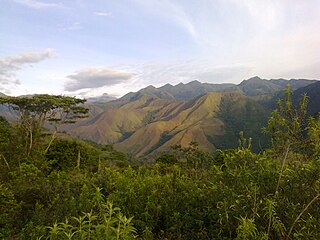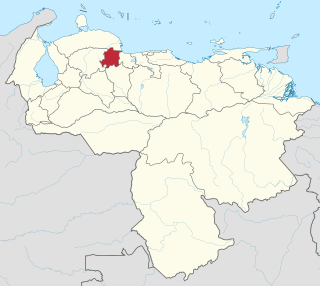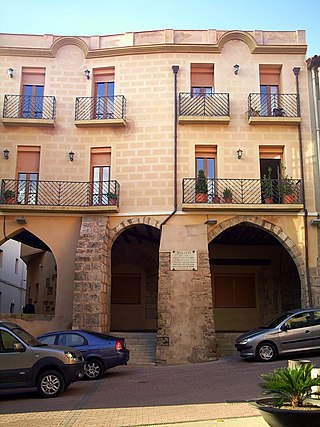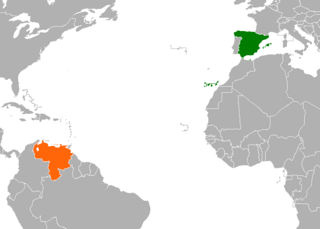
Venezuela, officially the Bolivarian Republic of Venezuela, is a country on the northern coast of South America, consisting of a continental landmass and many islands and islets in the Caribbean Sea. It comprises an area of 916,445 km2 (353,841 sq mi), and its population was estimated at 29 million in 2022. The capital and largest urban agglomeration is the city of Caracas. The continental territory is bordered on the north by the Caribbean Sea and the Atlantic Ocean, on the west by Colombia, Brazil on the south, Trinidad and Tobago to the north-east and on the east by Guyana. Venezuela is a presidential republic consisting of 23 states, the Capital District and federal dependencies covering Venezuela's offshore islands. Venezuela is among the most urbanized countries in Latin America; the vast majority of Venezuelans live in the cities of the north and in the capital.

Caracas, officially Santiago de León de Caracas (CCS), is the capital and largest city of Venezuela, and the center of the Metropolitan Region of Caracas. Caracas is located along the Guaire River in the northern part of the country, within the Caracas Valley of the Venezuelan coastal mountain range. The valley is close to the Caribbean Sea, separated from the coast by a steep 2,200-meter-high (7,200 ft) mountain range, Cerro El Ávila; to the south there are more hills and mountains. The Metropolitan Region of Caracas has an estimated population of almost 5 million inhabitants.

Zulia State is one of the 23 states of Venezuela. The state capital is Maracaibo. As of the 2011 census, it has a population of 3,704,404, the largest population among Venezuela's states. It is also one of the few states in Venezuela in which voseo is widespread. The state is coterminous with the eponymous region of Zulia.

Maracaibo is a city and municipality in northwestern Venezuela, on the western shore of the strait that connects Lake Maracaibo to the Gulf of Venezuela. It is the second-largest city in Venezuela, after the national capital, Caracas, and the capital of the state of Zulia. The population of the city is approximately 2,658,355 with the metropolitan area estimated at 5,278,448 as of 2010. Maracaibo is nicknamed "The Beloved Land of the Sun".

The current eight-star flag of Venezuela was introduced in 2006. The basic design includes a horizontal tricolour of yellow, blue, and red, dating to the original flag introduced in 1811, in the Venezuelan War of Independence.

Amazonas State is one of the 23 states into which Venezuela is divided. It covers nearly a fifth of the area of Venezuela, but has less than 1% of Venezuela's population.

Trujillo State is one of the 23 states of Venezuela. Its capital is Trujillo and the largest city is Valera. The state is divided into 20 municipalities and 93 parishes. Trujillo State covers a total surface area of 7,198 km2 (2,779 sq mi) and, has a 2011 census population of 686,367.

Yaracuy is one of the 23 states of Venezuela. Yaracuy is located in the Central-Western Region, Venezuela. It is bordered by Falcón in the north, in the west by Lara, in the south by Portuguesa and Cojedes and in the east by Cojedes and Carabobo.

The Venezuelan Declaration of Independence is a document drafted and adopted by Venezuelan on July 5, 1811, through which Venezuelans made the decision to separate from the Spanish Crown in order to establish a new nation based on the premises of equality of individuals, abolition of censorship and dedication to freedom of expression. These principles were enshrined as a constitutional principle for the new nation and were radically opposed to the political, cultural, and social practices that had existed during three hundred years of colonization.

The Second Republic of Venezuela is the name used to refer to the reestablished Venezuelan Republic declared by Simón Bolívar on 7 August 1813. This declaration followed the defeat of Domingo Monteverde by Bolívar during the Admirable Campaign in the west and Santiago Mariño in his campaign in the east.
The Republic came to an end in the following year, when Caracas was reoccupied by the Royalists on 16 July 1814, after a series of defeats at the hands of José Tomás Boves.

The First Republic of Venezuela was the first independent government of Venezuela, lasting from 5 July 1811, to 25 July 1812. The period of the First Republic began with the overthrow of the Spanish colonial authorities and the establishment of the Junta Suprema de Caracas on 19 April 1810, initiating the Venezuelan War of Independence, and ended with the surrender of the republican forces to the Spanish Captain Domingo de Monteverde. The congress of Venezuela declared the nation's independence on 5 July 1811, and later wrote a constitution for it. In doing so, Venezuela is notable for being the first Spanish American colony to declare its independence.

The Captaincy General of Venezuela, was an administrative district of colonial Spain, created on September 8, 1777, through the Royal Decree of Graces of 1777, to provide more autonomy for the provinces of Venezuela, previously under the jurisdiction of the Audiencia of Santo Domingo and then the Viceroyalty of New Granada. It established a unified government in political (governorship), military, fiscal (intendancy), ecclesiastical (archdiocese) and judicial (audiencia) affairs. Its creation was part of the Bourbon Reforms and laid the groundwork for the future nation of Venezuela, in particular by orienting the province of Maracaibo towards the province of Caracas.

The Guipuzcoan Company of Caracas was a Spanish chartered company which existed from 1728 to 1785. It conducted trade with Spain's overseas colonies and maintained its own fleet of warships to defend the company's merchantmen. In 1785, after having several of its ships captured by the British Royal Navy during the American Revolutionary War, the Guipuzcoan Company of Caracas was merged with the Barcelona Trading Company to form the Royal Company of the Philippines.

The Venezuela Province was a province of the Spanish Empire, of Gran Colombia (1824–1830) and later of Venezuela, apart from an interlude (1528–1546) when it was contracted as a concession by the King of Spain to the German Welser banking family, as Klein-Venedig.
Spanish expeditions led by Columbus and Alonso de Ojeda reached the coast of present-day Venezuela in 1498 and 1499. The first colonial exploitation was of the pearl oysters of the "Pearl Islands". Spain established its first permanent South American settlement in the present-day city of Cumaná in 1502, and in 1577 Caracas became the capital of the Province of Venezuela. There was also for a few years a German colony at Klein-Venedig.

Joan Orpí i del Pou, also Juan Orpín or Juan Urpín was a Spanish conquistador, known for founding New Barcelona in Venezuela, and for founding the short-lived Province of New Catalonia (1633–1654).

The Governorate of New Andalusia was a Spanish colonial entity in what today constitutes the Caribbean coastal territories from Central America, Colombia and Venezuela, and the islands of what today are Jamaica, Cuba, Haiti, Dominican Republic and Puerto Rico. The Government of Nueva Andalucia was set in Venezuela from 1501 to 1513.

Spain–Venezuelan relations are the bilateral relations between the Kingdom of Spain and the Bolivarian Republic of Venezuela. Both nations are members of the Association of Spanish Language Academies and the Organization of Ibero-American States.

The Third Republic of Venezuela is the reestablished Republic of Venezuela declared by Simón Bolívar in the year 1817, during the Venezuelan War of Independence.

















